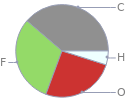Input interpretation

acetyl fluoride | elemental composition
Result

Find the elemental composition for acetyl fluoride in terms of the atom and mass percents: atom percent = N_i/N_atoms × 100% mass percent = (N_im_i)/m × 100% Plan: • Write the chemical formula and gather atomic masses from the periodic table. • Determine values for N_i, m_i, N_atoms and m using these items. • Finally, compute the percents and check the results. Write the chemical formula: CH_3COF Use the chemical formula to count the number of atoms, N_i, for each element and find the total number of atoms, N_atoms, per molecule: | number of atoms C (carbon) | 2 F (fluorine) | 1 H (hydrogen) | 3 O (oxygen) | 1 N_atoms = 2 + 1 + 3 + 1 = 7 Divide each N_i by N_atoms to calculate atom fractions. Then use the property that atom fractions must sum to one to check the work: | number of atoms | atom fraction C (carbon) | 2 | 2/7 F (fluorine) | 1 | 1/7 H (hydrogen) | 3 | 3/7 O (oxygen) | 1 | 1/7 Check: 2/7 + 1/7 + 3/7 + 1/7 = 1 Compute atom percents using the atom fractions: | number of atoms | atom percent C (carbon) | 2 | 2/7 × 100% = 28.6% F (fluorine) | 1 | 1/7 × 100% = 14.3% H (hydrogen) | 3 | 3/7 × 100% = 42.9% O (oxygen) | 1 | 1/7 × 100% = 14.3% Look up the atomic mass, m_i, in unified atomic mass units, u, for each element in the periodic table: | number of atoms | atom percent | atomic mass/u C (carbon) | 2 | 28.6% | 12.011 F (fluorine) | 1 | 14.3% | 18.998403163 H (hydrogen) | 3 | 42.9% | 1.008 O (oxygen) | 1 | 14.3% | 15.999 Multiply N_i by m_i to compute the mass for each element. Then sum those values to compute the molecular mass, m: | number of atoms | atom percent | atomic mass/u | mass/u C (carbon) | 2 | 28.6% | 12.011 | 2 × 12.011 = 24.022 F (fluorine) | 1 | 14.3% | 18.998403163 | 1 × 18.998403163 = 18.998403163 H (hydrogen) | 3 | 42.9% | 1.008 | 3 × 1.008 = 3.024 O (oxygen) | 1 | 14.3% | 15.999 | 1 × 15.999 = 15.999 m = 24.022 u + 18.998403163 u + 3.024 u + 15.999 u = 62.043403163 u Divide the mass for each element by m to calculate mass fractions. Then use the property that mass fractions must sum to one to check the work: | number of atoms | atom percent | mass fraction C (carbon) | 2 | 28.6% | 24.022/62.043403163 F (fluorine) | 1 | 14.3% | 18.998403163/62.043403163 H (hydrogen) | 3 | 42.9% | 3.024/62.043403163 O (oxygen) | 1 | 14.3% | 15.999/62.043403163 Check: 24.022/62.043403163 + 18.998403163/62.043403163 + 3.024/62.043403163 + 15.999/62.043403163 = 1 Compute mass percents using the mass fractions: Answer: | | | number of atoms | atom percent | mass percent C (carbon) | 2 | 28.6% | 24.022/62.043403163 × 100% = 38.72% F (fluorine) | 1 | 14.3% | 18.998403163/62.043403163 × 100% = 30.62% H (hydrogen) | 3 | 42.9% | 3.024/62.043403163 × 100% = 4.874% O (oxygen) | 1 | 14.3% | 15.999/62.043403163 × 100% = 25.79%
Mass fraction pie chart

Mass fraction pie chart